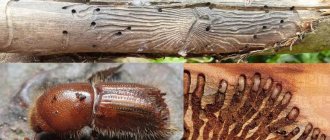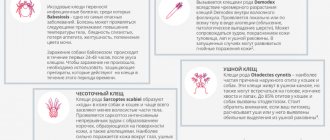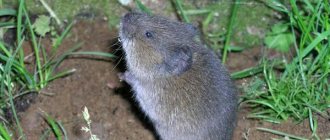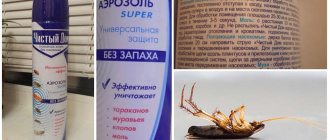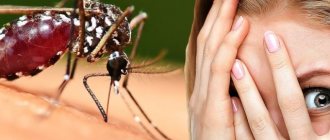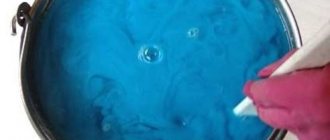Views: 635
So we got to the baiting of bedbugs, cockroaches and other insects with “chemistry”. It is immediately worth noting that this is the most effective approach . This means that chemical disinfestation methods, as a rule, give the best results among all others . However, other methods should not be neglected either, since “chemistry” is not only effective, but also often unsafe. Therefore, in “mild cases” and for prevention purposes, it is better to resort to more environmentally friendly methods of exterminating insects .
We described other methods and types of insect control here:
– Biological methods of exterminating insects
– Mechanical methods of exterminating insects
– Physical methods of exterminating insects
– What is disinfestation? Types of pest control
Content
- 1. Diazinon
- 2. Imidacloprid
- 3. Fipronil
- 4. Inorganic insecticides.
- 5. Malathion (karbofos)
- 6. Pirimiphos-methyl
- 7. Pyrethroids
- 8. Biological insecticides
- 8.1. Avermectins
- 8.2. Bacterial insecticides
- 8.3. Entomopathogenic nematodes
- 9. Thiamethoxam
- 10. Plant insecticides
Among the many insecticidal preparations, how to understand and choose the best insecticides that are used more often and have maximum effectiveness.
TOP 10 best groups of insecticides containing the following active ingredients:
| Active ingredient/chemical class | Examples of drugs |
| 1.DIAZINON | Thunder-2, Vallar, Ant, Anteater, etc. |
| 2.IMIDACLOPRID | Biotlin, Iskra Zolotaya, Prestige, Imidor, Tanrek, Commander, etc. |
| 3.FIPRONIL | Regent, HECTOR from the ants |
| 4. Inorganic insecticides | Ecokiller (diatomite powder), Thiovit Jet (sulfur), Dohlox - boric gel/traps/balls (boric acid), Antiant, etc. |
| 5.MALTHION | Karbofos, Alatar, Antiklesch, Aliot, Fenaxin, Fufanon-Nova/Expert, etc. |
| 6.PIRIMIFOS-METHYL | Aktellik |
| 7.PYRETHROIDS | Cypermethrin-25, Decis, FAS, Taran, Inta-Vir, Alatar, etc. |
| 8. Biological insecticides | |
| 8.1.Avermectins | Fitoverm, Kleschevit, Vertimek, Biokill, Akarin, etc. |
| 8.2.Bacterial insecticides | Bitoxibacillin, Lepidocid, etc. |
| 8.3.Entomopathogenic nematodes | Nemabact |
| 9.THIAMETHOXAM | Aktara |
| 10.Plant insecticides | Antitlin, Tabazol, Tobacco dust, etc. |
Diazinon
Diazinon-based insecticides are classified as organophosphorus compounds. Available in the form of granules (3-10%) or emulsion concentrate (60%)
| Examples of drugs | Barguzin, Vallar, Grom, Grom-2, Diazinon-600, Diazol, Zemlin, Medvegon, Anteater, Ant, Praktik, Provotox, Ricochet, Terradox, etc. |
| Purpose | These are drugs of non-systemic action, but with a wide range of applications. Diazinon is practically insoluble in the aquatic environment, which makes it possible to combat soil-dwelling pests and pests living on the soil surface. The purpose of these insecticides is to control the number of wireworms, chafer/chafer larvae, garden ants, weevils, cabbage and onion flies, aphids, etc. The drugs also have an acaricidal effect, which makes them possible to use against ticks. They are also used for medical and household disinfestation to combat various insects, including synanthropic insects. The preparations are used to protect indoor flowers from soil flies and fungus gnats. |
| Application | Plants are treated by spraying or scattered over the surface or introduced into the soil. The active substance is absorbed by the root system and enters the vegetative parts. The period of protective action is about 4 weeks. |
| Peculiarities | a) With systematic use, group resistance to drugs is observed b) Preparations based on diazinon are non-phytotoxic, however, treatment of seeds and roots can lead to plant inhibition. Contaminates the soil. |
Mechanical and biological methods
Plant pests multiply very quickly, attacking fruit and vegetable crops. If there are still a few of them in the garden, you can act without the use of poisons:
- Collection by hand. The method is effective in controlling aphids and other garden pests if several individuals are found on the foliage. You can collect insects or pick off the foliage on which they live. Leaves are immediately destroyed or burned.
- Attracting other insects and birds that feed on parasites. For example, ladybugs and lacewings are effective against aphids. This method is suitable in the initial stages of infection or as a preventative measure.
- Destruction of anthills. They breed pests to feed on their secretions. By destroying anthills, you can reduce the parasite population.
Read more: How to drive away ants forever
- Planting plants with repellent scents. Marigolds, mint, dill, and garlic repel pests of fruit crops with their pungent odor.
- Irrigation with water. Direct a stream of water from a hose onto the affected plants. It washes the insects to the ground, where they are eaten by birds. Regular treatment of plants with water will help get rid of parasites.
Related article:
Powdery mildew: description of a dangerous disease
Mechanical and biological methods do not work if there are a lot of pests and they have infected most of the plantings. In this case, more radical measures will be required.
Imidacloprid
Insecticides based on imidacloprid are classified as neonicotinoids, the formulation is an emulsion concentrate with a dosage of 0.001-50%
| Examples of drugs | Akiba, Biotlin, Beetle-eater, Beetle-borer, Zaman, Bison, Imidor, Iskra Zolotaya, Kalash, Klubneshield, Commander, Konfidelin, Confidor, Corado, Colorado, Kortlis, Movento Energy, Monsoon, Pinotsid, Patron, Prestige, Prestigator, Rank, Rembek, Respect, Rofatox, Rubezh, Tabu, Tanrek, Tsvetolyuks, etc. |
| Purpose | These are drugs of a systemic principle of action, and they spread through plant cells to all vegetative parts of the plant. The drugs have proven themselves to be effective in the fight against the Colorado potato beetle; the drugs are used for pre-planting treatment of potatoes, since imidacloprid is highly persistent in the soil, with a half-life of up to 100 days. In agricultural production they are used to protect wheat and grains from a complex of pests (bug bugs, aphids, bread beetles, wheat thrips, flea beetles, leech beetles, stem sawflies). In private household plots they are widely used against pests of cucumber, tomato in protected soil (aphids, greenhouse whitefly) and fruit and berry crops (aphids, apple flower beetle). Imidacloprid-based preparations are also used to kill cockroaches, ants and other crawling insects. |
| Application | Treatment is carried out by spraying or applying through drip irrigation. The speed of initial impact is 3-5 days after treatment. The period of protective action is 14-28 days. |
| Peculiarities | a) Preparations based on imidacloprid also have an anti-stress effect on agricultural crops. b) High hazard class for bees; in Europe, use is allowed only in protected soil. Extremely dangerous for mammals, birds and fish. Requires compliance with safety precautions. c) A study of the dynamics of residues in plants showed that imidacloprid penetrates mainly into the leaves through the vascular system and practically does not enter the fruits. |
Fipronil
Fipronil-based insecticides belong to the chemical class of phenylpyrazoles. Preparative forms - water-dispersible granules (80%), emulsion concentrate (4%), and also used in the composition of gels against crawling insects.
| Examples of drugs | Aria, Monarch, Regent, Taboo Super, Fumitox, gel, etc. |
| Purpose | Fipronil is effective against plant pests from the orders Orthoptera and Coleoptera, as well as soil-dwelling pests. Today this is one of the best for controlling the number of synanthropic insects - cockroaches, ants, etc. (for example, the drug "Regent VDG") Also used in veterinary medicine against fleas and ticks. |
| Peculiarities | a) Has high long-term insecticidal toxicity. b) High toxicity to bees - hazard class 1. c) In household disinsection, due to the high toxicity of the substance for warm-blooded animals, only bait stations and gels are allowed. |
Aktara
A broad-spectrum pest control product containing thiamethoxam. The poison from the tissue of the eaten leaves enters the pest’s body and paralyzes the nervous system. "Aktara" is a product of moderate danger class.
| Options | Description |
| Advantages | Does not damage foliage, improves growth and productivity, protection period is 2 months. with minimal spraying, the product is effective within 2 hours, complete protection of plants from pests |
| Flaws | Toxic to bees, the solution loses its properties during storage and is addictive, the drug must be alternated with another insecticide |
| How to cook | Dissolve the concentrate (granules) in a large amount of water, spray the plants with a spray bottle |
| What pests does it affect? | Insects living inside plants, bees, rodents, aphids, mites, copperheads, whiteflies, scale insects, Colorado potato beetles, false scale insects |
| Consumption per area | 100 sq. m – 2-4 buckets of solution depending on the height of the crops |
| Price | 1 ml – 30-70 rubles, 1.2 ml – 30-125 rubles, 3 ml – from 245 rubles, 4 g – 75-100 rubles. |
| Can edible crops be processed? | Yes, the fruits can be consumed after 2 months, when the drug is completely released from the plant |
Inorganic insecticides.
This is a large group of pesticides; inorganic compounds are used as active ingredients - diatomaceous earth, boric acid, sodium tetraborate/borax, sulfur, etc. They are used to protect stocks from pests, also for sanitary and household disinfestation, and in veterinary medicine. Examples of drugs are Ecokiller, Thiovit Jet, Dohlox-boron gel/traps, Antiant.
In this group, special mention should be made of the innovative insect repellent “ Ecokiller ”. The basis of the preparations is DIATOMITE (diatomite powder), which has abrasive and absorbent characteristics. Its tiny particles attach to the surface of the insect and absorb lipids (fats) from the outer chitinous layer of the shell. As a result, the protective film that retains water is destroyed, and insects (adults, nymphs, larvae) die from dehydration. Ecokiller drugs are unique - on the one hand, they are extremely effective, do not cause resistance, have a large population coverage, and on the other hand, they are absolutely safe and environmentally friendly.
More information about Ecokiller preparations
Line of produced insecticidal preparations of the Ecokiller series
Preparations for treating plants against pests
Make sure that at the time of flowering the ants do not eat the blackcurrant ovaries. If the bushes bloom but don’t produce berries, that’s their job. To protect against ants, place a rag soaked in kerosene under the bushes (but please do not water the soil with kerosene).
Ants
Ant larvae
Ants and many other insects do not like this smell. You can put a drop of any anti-ant gel on each trunk growing from the ground. A good product for controlling plant pests is the Great Warrior . Insects will come running to the bait. Since the ants not only eat themselves, but also carry prey to the anthill, each of them, except themselves, will destroy a lot of their relatives, and most importantly, the queen will die. (By the way, this drug acts on wasps in exactly the same way.) If a large number of ants are scurrying around on the soil under the bushes, remove about 2 cm of the top layer of soil; most likely, you will find oviposition there. Pollinate it with the drug against plant pests “Phenaxin” or “Ant” (the drugs have low toxicity for other insects and warm-blooded inhabitants of the garden). Ants and eggs will die under the influence of the drug.
Bud mite on black currants
Bud mite on black currants
Check for bud mites on black currants - the pests are found in large, round, swollen buds that are very different from other buds and are clearly visible. Diseased kidneys should be picked and burned, and not thrown away anywhere or composted. When the black currant blooms, look to see if any bush has irregular flowers with narrow fused petals of a dirty pink color. This indicates a very dangerous and contagious disease - terry. Immediately uproot and burn such a bush, even if you find flowers on just one branch.
Malathion (karbofos)
Insecticides based on malathion belong to the class of organophosphorus compounds (OPC), Preparative forms - aqueous emulsion (44%), granules (5%), emulsion concentrate (1.3-57%), tablets (14%)
| Examples of drugs | Aliot, Alatar, Antiklesch, Inta-CM, Iskra-M, Karbotsin, Karbofos-500, Medilis-Malathion, Profilaktin, Fufanon-Nova/Expert, Fufanon-Super, Foscon-55, Phenaxin, Tsipromal, etc. |
| Purpose | Widely used in agriculture to combat harmful insects (sucking and gnawing). Malathion is effective against herbivorous mites and scale insects. Malathion, together with pyrethroids, is used against stock pests. In addition, it is used for sanitary and household disinsection. In medical practice as an anti-pediculosis agent (for lice) |
| Application | The period of protective action in open ground is up to 10 days, for protected ground – 5 – 7 days. |
| Peculiarities | a) With the systematic use of malathion, stable populations of insects and mites appear, which requires alternation with other insecticides. b) Excellent ratio - low toxicity for warm-blooded animals and high toxicity for insects and ticks (due to the principle of action). c) It is rarely used in open ground because it is not resistant to wind and water. d) Malathion does not change the smell or taste of food. |
Folk remedies
Although insecticides are effective, they may be unsafe for beneficial insects and animals living in the dacha area. Less toxic control agents should also be selected during harvest. Traditional recipes do not allow you to quickly deal with colonies of parasites, but they can be used regularly without fear. Popular garden pest control products include:
- Vodka. Suitable for treating bushes and fruit trees. 20 g of grated laundry soap is diluted with a small amount of water and mixed with 1 liter of vodka. The solution is sprayed on areas where parasites accumulate.
- Coca Cola. Carbonated water contains phosphoric acid, which insects cannot tolerate. 2 liters of the drink are diluted in 7 liters of water and the plantings are treated.
- Laundry soap. The product contains coproic acid, which destroys up to 90% of parasites. 300 g of soap shavings are poured into 2 liters of warm water and stirred until dissolved. The volume of the solution is adjusted to 10 liters and the affected plantings are sprayed.
- Ammonia. 2 tbsp. l. alcohol and 2 tbsp. l. tar soap is added to 10 liters of water. Ammonia causes intoxication and leads to the death of insects.
Related article:
10 ideas on how to get rid of mice in a country house (only proven means!)
- Soda ash (lye). Upon contact with this product, ulcers appear on the body of the pests, and the colonies leave the plantings. 100 g tar soap shavings and 0.5 tbsp. l. Dilute soda in 1 liter of warm water. The solution is used for spraying plantings.
- Ash. Works on the principle of soda ash. It irritates the insect's body, and the pest moves to other plants outside the affected area. 2 tbsp. The ash is diluted in 10 liters of water and the crops are treated.
- Hot pepper. 1 kg of pods is cut and filled with a bucket of water. Leave for 10 days and treat the affected plants.
Pyrethroids
Pyrethroids / pyrethrins are a large group of pesticides with various active ingredients - deltamethrin, bifethrin, permethrin, cyperemethrin (with isomers - alpha, beta, gamma), etc. Preparative forms - water-soluble powder (3.75%), emulsion concentrate (5- 25%), wettable powder (2.1%), tablets (2.9-3.75%)
| Examples of drugs | Alfacin, Arrivo, Alatar, Zhukoed, Forsyth, Qi-alpha, Decis, FAS, Taran, Eforia, Iskra, Medilis-Antiklop, Medilis-Tsiper, Karbotsin, Inta-Vir, Cytox, Cypermethrin-25, etc. |
| Purpose | Widely used for the protection of grapes (leaf rollers), potatoes (Colorado beetle, potato ladybug), cucumbers, protected soil tomatoes (whiteflies, aphids, thrips), apple trees (codling moth, leaf rollers), currants (aphids, moths, leaf rollers, sawflies), and also from stock pests. Two-component preparations (malathion + cypermethrin, cypermethrin + permethrin) give a good effect. For the purposes of medical, sanitary and household disinfestation, pyrethroids are used to destroy flightless household insects (bed bugs, various types of cockroaches, ants and fleas). A number of pyrethroids in this group also have an acaricidal effect (for example, based on bifethrin). |
| Application | The protective effect lasts up to 15–20 days, the waiting period is 20–30 days. |
| Peculiarities | a) Effective fumigant. b) They have selectivity. c) The preparations are not phytotoxic, do not accumulate and are capable of decomposition in plant tissues and soil within up to 20 days. e) Dangerous for bees, I require compliance with appropriate safety measures. d) Long-term use of pyrethroids causes resistance. |
Fitosporin
A biological product with antifungal and antibacterial effects. "Fitsporin" is used to treat seed material, soil, and the root system of seedlings. The composition includes Bacillus subtilis - a bacterium that kills infections and can withstand temperatures from -50 to +40 ° C and unfavorable climatic conditions. Available in concentrate, powder, paste format.
| Options | Description |
| Advantages | The composition includes bioadditives that have a positive effect on the life of the plant, they are used at any time of the growing season, the active components of the product are able to adapt to unfavorable conditions, the protection period is 20 days, can be combined with growth stimulants |
| Flaws | Ineffective in bright sun, if the proportions are not correct, it loses its properties and requires repeated spraying |
| How to cook | 5 g mixed with 10 liters of water |
| What pests does it affect? | Black rot, powdery mildew, septoria, scab, rust, spotting, late blight, tracheomycosis |
| Consumption per area | 1 l/10 sq. m |
| Price | 10 g – 20 rub., paste (200 g) – 75 rub. |
| Can edible crops be processed? | Yes, the bacterial spores contained in the drug are safe for humans and are included in medications for the treatment of intestinal diseases. The fruits are consumed from the day of spraying. |
Biological insecticides
Three subgroups of biological insecticides can be noted that are currently widely used and show the best results.
8.1. Avermectins
Avermectins are waste products of the fungi Streptomyces avermitilis.
Examples of drugs are Vertimek, Biokill, Fitoverm, Kleschevit, Akarin.
Purpose – control of the number of pests of vegetable, fruit and ornamental crops, including pests of indoor plants.
The drugs do not have a systemic effect. The period of protective action is short: 5 – 7 days. The main advantage is environmental and biological safety; they practically do not accumulate in plant products.
8.2. Bacterial insecticides
Bacteriological insecticidal preparations are most often obtained based on the entomopathogenic bacterium Bacillus thuringiensis.
Examples of drugs are Lepidotsid, Bitoxibacillin, Baktsid, Biostop, etc. The purpose of these drugs is highly specific - they act only on insect larvae.
8.3. Entomopathogenic nematodes
The active ingredients of insecticides are an aqueous suspension of roundworms carrying symbiotic bacteria that develop infections in the body cavity, spreading to all organs and tissues, from which the insects die.
More information about the drug "Nemabact, VS"


